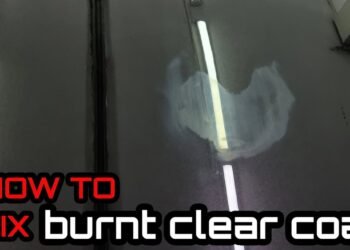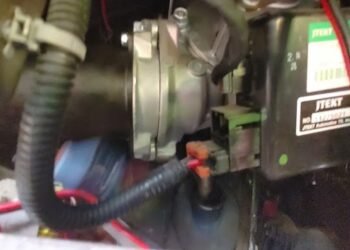If you’re wondering whether ceramic coating can be applied to single-stage paint, you’re not alone. You might have heard mixed opinions or worried about damaging your car’s finish.
The truth is, ceramic coating can work wonders on single-stage paint—but only if you prepare your surface the right way. Imagine locking in a deep shine that lasts and protects your paint from daily wear. Sounds good, right? But here’s the catch: single-stage paint is a single layer, so any imperfections you leave behind will be sealed forever.
That’s why understanding the proper steps before applying ceramic coating is key to getting that flawless, durable finish you want. Keep reading to discover how to make ceramic coating on single-stage paint not just possible, but truly effective for your vehicle.
Single-stage Paint Basics
Single-stage paint is a popular choice for many vehicles. Understanding its basics helps in maintaining and protecting the finish. This knowledge is key before applying ceramic coating to single-stage paint.
Single-stage paint combines color and gloss in one layer. This makes it different from more complex paint systems. Proper care can keep the paint looking fresh and shiny for years.
What Is Single-stage Paint
Single-stage paint includes both color and clear coat in one layer. It does not need an extra clear coat for shine or protection. This type of paint was common in older cars and some newer models.
The finish depends on the paint itself, so it must be well-maintained. Scratches and imperfections show easily because there is no clear layer above the color. This makes preparation important before applying any protective coating.
Differences From Basecoat/clearcoat
Basecoat/clearcoat paint uses two layers: a color base and a clear protective coat. The clearcoat gives extra shine and guards against damage. Single-stage paint does not have this extra protection.
Because of the lack of a clear coat, single-stage paint can fade or chip faster. It also needs more care to keep its look. Ceramic coating on single-stage paint seals the surface but requires perfect preparation.
Single-stage paint is simpler but more vulnerable. Basecoat/clearcoat systems offer better durability and gloss. Knowing these differences helps to choose the right care and coating process.

Credit: www.youtube.com
Ceramic Coating Benefits
Ceramic coating offers several benefits for vehicles with single-stage paint. It enhances the paint’s look and provides strong protection. This coating creates a shield that guards the paint from daily wear and tear. Applying ceramic coating on single-stage paint requires careful surface preparation to achieve the best results.
Protection Features
Ceramic coating forms a hard, protective layer on the paint surface. It guards against UV rays that can cause fading. Dirt and grime stick less to the coated surface, making cleaning easier. The coating also resists water, oil, and chemical stains. This protection helps keep the paint looking new for longer.
Enhancing Shine
The coating adds a deep, glossy shine to single-stage paint. It highlights the paint’s color and smoothness. This shine lasts longer than traditional wax or sealants. The coating reduces surface imperfections, improving the overall appearance. The result is a clean, bright finish that stands out.
Durability On Single-stage Paint
Ceramic coating is tough and long-lasting. It bonds well with single-stage paint when properly applied. This durability protects the paint from scratches and minor damage. Unlike wax, it does not wash away after a few washes. The coating maintains its protective qualities for months or even years.
Surface Preparation Steps
Proper surface preparation is the key to a successful ceramic coating on single-stage paint. This paint type has only one layer, so every imperfection gets sealed permanently. Preparing the surface carefully ensures a smooth, durable finish that protects and shines.
Each step removes dirt, imperfections, and oils that can affect the coating’s bond. The process includes cleaning, polishing, and wiping down the paint. Following these steps helps the coating last longer and look better.
Cleaning And Decontamination
Start by washing the car thoroughly with a gentle soap. Remove all dirt, dust, and grime from the surface. Use a clay bar to pull out embedded contaminants. This step clears the paint of particles that simple washing misses. A clean surface is vital for the coating to stick properly.
Polishing And Paint Correction
Polish the paint to remove scratches and swirl marks. Use a fine polish and a soft pad for single-stage paint. This step enhances the paint’s shine and smoothness. Correcting paint defects improves how the coating bonds and looks. Take care not to over-polish, as single-stage paint is thinner than clear coat finishes.
Isopropyl Alcohol Wipe-down
Wipe the surface with isopropyl alcohol (IPA) to remove oils and residues. IPA cleans off polish oils and any leftover contaminants. Use a clean microfiber towel for this step. This wipe-down leaves the paint perfectly clean and ready for ceramic coating. Skipping this step can cause poor adhesion and spotting.
Applying Ceramic Coating
Applying ceramic coating on single-stage paint requires care and precision. The process protects the paint and enhances its shine. Proper steps ensure the coating bonds well and lasts longer. Understanding how to apply the coating helps avoid mistakes and achieve a smooth finish.
Choosing The Right Coating
Select a ceramic coating designed for single-stage paint. Some coatings are better for modern single-stage paint, while others suit older types. Check the product label for compatibility. A good coating will protect against UV rays, dirt, and water spots. Avoid coatings that may cause blotchiness or uneven shine on single-stage finishes.
Test Spot Importance
Perform a test spot before full application. Pick a small, hidden area on the car. Apply the coating there and observe the results. This step shows how the coating bonds with your paint. It also helps detect any color changes or blotches early. Testing saves time and prevents large-scale issues.
Application Techniques
Clean the surface thoroughly before applying coating. Use a microfiber cloth and isopropyl alcohol to remove oils. Apply the coating in small sections for better control. Use a soft applicator pad to spread the product evenly. Avoid applying too much coating at once to prevent streaks. Let each section cure as instructed before moving to the next.
Special Considerations
Ceramic coating on single-stage paint demands special care. This paint type is a single layer without a clear coat. The coating seals every detail on the surface. Imperfections and damage become permanent if not fixed first. Understanding these unique traits helps achieve the best results.
Modern Vs. Older Single-stage Paint
Modern single-stage paints use advanced formulas. They tend to be more durable and flexible. Older single-stage paints may be brittle and prone to cracking. Modern paints bond better with ceramic coatings. Older paints require gentler handling and testing. Knowing the paint age guides preparation and product choice.
Handling Delicate Or Aging Paint
Delicate or aging single-stage paint needs careful cleaning. Avoid aggressive polishing that can thin the paint. Use mild compounds and soft pads to correct defects. Always test on a small area first. Protective coatings can extend the life of fragile paint. Proper maintenance prevents further wear and fading.
Common Mistakes To Avoid
Skipping thorough surface cleaning leads to poor coating adhesion. Applying ceramic coating on damaged paint traps flaws permanently. Using harsh polishes can damage thin single-stage layers. Not testing a small section risks uneven finish or staining. Rushing the curing time reduces coating durability. Take time and follow steps precisely for best results.

Credit: www.reddit.com
Maintenance After Coating
Maintaining ceramic coating on single-stage paint is essential to keep its shine and protection long-lasting. The coating forms a strong barrier but needs gentle care to stay effective. Proper maintenance helps preserve the paint’s smooth finish and prevents damage from dirt, water spots, and contaminants.
Regular upkeep ensures the coating continues to protect the paint against harsh elements. It also keeps the vehicle looking clean and glossy. Understanding how to care for coated single-stage paint will save time and money on repairs or repainting.
Caring For Coated Single-stage Paint
Handle the coated surface with care to avoid scratches or swirls. Use soft microfiber towels for drying and wiping. Avoid abrasive cloths or brushes that can damage the coating’s layer. Park the vehicle in shaded areas to reduce UV exposure that can degrade the coating.
Keep the paint free of bird droppings, tree sap, and other contaminants by cleaning them off quickly. These substances can weaken the coating if left on too long. Avoid harsh chemicals or strong detergents that strip away the ceramic layer.
Cleaning Tips
Wash the vehicle regularly with a pH-neutral car shampoo designed for ceramic coatings. Use plenty of water to rinse off dirt and grime gently. Avoid automatic car washes with harsh brushes or strong chemicals that may harm the coating.
Use a two-bucket wash method to reduce the risk of scratching the paint. One bucket for soap, the other for rinsing your wash mitt. Dry the car with a clean microfiber towel to prevent water spots and streaks.
When To Reapply Coating
The ceramic coating does not last forever. Check the surface every six to twelve months for signs of wear. Look for dull areas, water spots, or reduced water beading effect. These signs mean the coating is losing its protective power.
Reapply the ceramic coating as needed to maintain the best protection. Follow the manufacturer’s instructions for application. Proper reapplication keeps the paint safe and looking fresh for years.

Credit: www.youtube.com
Frequently Asked Questions
Does Ceramic Coating Work On Single Stage Paint?
Yes, ceramic coating works on single-stage paint. Proper surface cleaning, polishing, and residue removal ensure strong bonding and lasting protection. Always test a small area first to check compatibility and avoid sealing imperfections permanently.
Can You Clearcoat Single Stage Paint?
Yes, you can clearcoat single-stage paint. Properly clean, polish, and prep the surface first. Clearcoat seals imperfections permanently, so surface condition matters. Test a small area to ensure good adhesion and finish before full application.
What Is The Downside To Ceramic Coating?
Ceramic coating can permanently seal paint imperfections if not properly prepared. It requires thorough cleaning and polishing. Older single-stage paints may react poorly. Test spots are necessary to avoid blotchiness. The coating’s effectiveness depends on the paint’s initial condition and compatibility.
What Are The Disadvantages Of Single Stage Paint?
Single stage paint can show imperfections easily and requires perfect surface prep before coating. It may fade faster and has less durability compared to multi-stage paint. Ceramic coating seals any flaws permanently, making correction essential. Older single stage paints are more delicate and prone to damage.
Can Ceramic Coating Be Applied On Single-stage Paint?
Yes, ceramic coating works on single-stage paint but requires careful surface preparation first.
Conclusion
Ceramic coating on single-stage paint protects and enhances its shine. Clean and polish the surface well before applying the coating. Any scratches or marks will become permanent if not fixed first. Testing a small area helps avoid unwanted reactions. Choose the right coating for your paint type.
This process keeps your vehicle looking fresh longer. Taking care now saves time and effort later. Simple steps lead to great results and lasting protection.

















